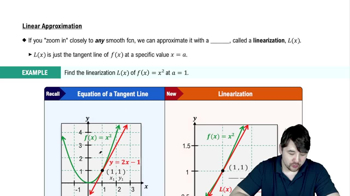Table of contents
- 0. Functions7h 52m
- Introduction to Functions16m
- Piecewise Functions10m
- Properties of Functions9m
- Common Functions1h 8m
- Transformations5m
- Combining Functions27m
- Exponent rules32m
- Exponential Functions28m
- Logarithmic Functions24m
- Properties of Logarithms34m
- Exponential & Logarithmic Equations35m
- Introduction to Trigonometric Functions38m
- Graphs of Trigonometric Functions44m
- Trigonometric Identities47m
- Inverse Trigonometric Functions48m
- 1. Limits and Continuity2h 2m
- 2. Intro to Derivatives1h 33m
- 3. Techniques of Differentiation3h 18m
- 4. Applications of Derivatives2h 38m
- 5. Graphical Applications of Derivatives6h 2m
- 6. Derivatives of Inverse, Exponential, & Logarithmic Functions2h 37m
- 7. Antiderivatives & Indefinite Integrals1h 26m
- 8. Definite Integrals3h 25m
4. Applications of Derivatives
Linearization
Problem 23
Textbook Question
21–32. Mean Value Theorem Consider the following functions on the given interval [a, b].
a. Determine whether the Mean Value Theorem applies to the following functions on the given interval [a, b].
b. If so, find the point(s) that are guaranteed to exist by the Mean Value Theorem.
ƒ(x) = { - 2x if x < 0 ; x if x ≥ 0 ; [-1, 1]
 Verified step by step guidance
Verified step by step guidance1
Identify the function f(x) and the interval [a, b] which is given as [-1, 1]. The function is piecewise defined: f(x) = -2x for x < 0 and f(x) = x for x ≥ 0.
Check if the function f(x) is continuous on the closed interval [-1, 1]. This involves verifying the continuity at the point where the definition of the function changes, which is at x = 0.
Determine if the function f(x) is differentiable on the open interval (-1, 1). This requires checking the derivative of f(x) in both pieces of the piecewise function and ensuring it exists at all points in the interval.
If the function is both continuous on [-1, 1] and differentiable on (-1, 1), apply the Mean Value Theorem, which states that there exists at least one point c in the interval (-1, 1) such that f'(c) = (f(b) - f(a)) / (b - a).
Calculate the values of f(-1) and f(1) to find the average rate of change over the interval, and then find the derivative f'(x) for both pieces of the function to solve for the point(s) c where f'(c) equals the average rate of change.
Recommended similar problem, with video answer:
 Verified Solution
Verified SolutionThis video solution was recommended by our tutors as helpful for the problem above
Video duration:
6mPlay a video:
Was this helpful?
Related Videos
Related Practice




